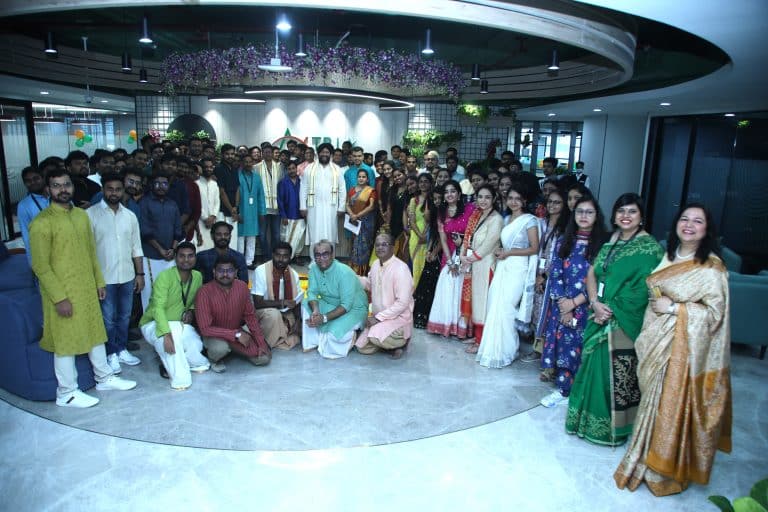“The space sector is a booming industry, and this is the right time to jump into it. At AAKA, we are very fortunate to have this opportunity to start India’s first space architectural firm”
Aastha Kacha
Indo-Canada based Space Architecture Firm AAKA Space Studio recently designed a Mars Analog habitat named “NOAH”, that is set to act as an intermediate shelter between the temporary and permanent settlements on Mars. NOAH is being built to test the deployability and durability of origami structures in extreme environments.
The prototype is to be tested in a three-month-long expedition, in the most severe environments like the area around Leh, India and the North Atlantic region, in November 2022.
NOAH is a Martian habitat that combines a scientific approach with avant-garde architecture, state-of-the-art engineering and profitable economics. During the analogue mission, relevant characteristics will be analysed in a high-fidelity environment to observe the performance of the habitat. Some of the subjects addressed will be hydroponics & aeroponics systems, life support systems, design deployability, psychological and physiological stressors, etc. The project’s main goal is to ensure that NOAH can protect its inhabitants, test new design ideas for such missions, and provide knowledge for any future development in the industry.
Recently, Analytics India Magazine was in conversation with Founder Aastha Kacha to understand the idea behind AAKA Space Studio and how technology plays a role in her new venture.
Aastha Kacha is an award-winning space architect, a two time TEDx speaker, technologist, and philanthropist. AAKA is a next-generation design practice with the vision to create interactive human-centred living spaces and integrate technical comprehension in analogue habitats for extraterrestrial, orbital, Lunar, and Mars missions. AAKA’s core vision is to design, build and test deployable habitable structures while integrating Origami into the architecture.
AIM: What was the thought behind creating AAKA Space Studio?
Space architecture is a new and emerging field all across the world. After winning a lunar design contract with a team during NASA Space Academy at the age of thirteen, I got vitalised to pursue architecture and become a space architect. After completing my graduation from VIA University, Denmark, I was desperately looking for opportunities in Space Architecture. Not finding enough, I went ahead to create one on my own, founding North and South Asia’s first Space Architecture Studio.
My mission with AAKA SPACE STUDIO is to push the boundaries for space architecture and find more cost-effective solutions to test, build and launch habitable volume in space. In addition to this, my other goals include:
- To establish and create awareness about space architecture.
- Space architecture development is said to cover 7 out of 16 UN-Sustainable Development Goals- to achieve SDGs. Therefore, to create affordable space architecture education in developing and under-developed countries.
AIM: Tell us about your latest project, “NOAH”. What, according to you, could be the potential breakthrough outcome from NOAH? Would you like to share your long-term vision behind AAKA Space studio?
NOAH is a Mars Analog habitat designed as an intermediate shelter between the temporary and permanent settlements on Mars. NOAH is being built to test the deployability and durability of origami structures in extreme environments. The prototype will be tested in a 3-month long expedition, in the most severe environments like the area around the North Atlantic region, in November 2022.
A team of 3 crewmembers will deploy the structure in an extreme environment with no external support, conduct various scientific experiments, perform EVAs (Extravehicular Activities), and report hours and other routine activities, to thrive on the Martian surface. NOAH might also be used as a military shelter or research laboratory in extreme terrestrial environments. Still, the main function that will be tackled is providing an Earth-like environment on Mars.
The end goal of AAKA is to prefabricate the modular space habitable module, and AAKA Space Studio is trying to achieve this goal by designing, building, and testing the current prototype NOAH- Next Generation Origami Analog Habitat.
AIM: What do you think about the demand for space architecture?
The commercialisation of the space sector in India opens up opportunities for growth in the space industry. The ISS is being replaced and commercialised; several nations are aiming to build their space stations. Space architecture will take a leading role in the future space mission; while talking about India, it has its plan to launch the International Space Station.
AIM: Do you think it’s a good time for companies to invest in the space domain?
In my opinion, this is the best time to invest in the space sector because so many countries, both developed and underdeveloped, are joining the space sector. Recently, I was invited to give a talk at the Kenya Space Agency, and I was taken aback by the motivation. One of the key reasons to invest this year and in the coming years is that there are many opportunities coming up for the private space sector. As one can see, recently, three private-sector launches have taken place through Virgin Galactic, Blue Origin, and SpaceX. India, itself, has launched the Indian Space Association, and the government is encouraging private companies to collaborate with the government for space missions from manufacturing to launching. The growth of the space sector will grow by 70% by 2030.
AIM: What do you like and dislike about the current state of the space research community?
The space sector is a booming industry, and this is the right time to jump into it. At AAKA, we are very fortunate to have this opportunity to start India’s first space architectural firm. One of the prominent things about space is that it brings us all together; there are no boundaries when we go to space. Space research is a challenging stream, and challenges help us build a better future on Earth. For example, some of the research under the space sector includes hydroponics (growing plants without much use of water), which eventually helps us grow food in a controlled environment.
Another such example is solar power and recyclable technology. Space is a harsh environment to live in. So astronauts have to recycle everything from food and water to waste, and so researching and finding better affordable recycling systems is helping advance and recycle resources on Earth.
The space research community is massive, and there are hundreds of opportunities to join various research groups according to the subject, but the key disadvantage is that there are government restrictions from country to country. For example, to join a space research community, in many cases, one has to be a US citizen. Another disadvantage is most of the research community is voluntary. Also, it is a challenge to find the grants/funding to execute the research, which is demotivating at times.
AIM: Do you think machine learning and artificial intelligence can play a big role in creating a better space ecosystem?
I believe that artificial intelligence has a lot to contribute to the space sector. Looking at the current scenario, AI has conquered most digital places and is a part of our daily lives. We can see that it is much developed, and we have the computation machinery available to utilise it to its full potential in the space sector. The space sector has started using ML and AI to search for life on other planets – Airbus and DLR have developed CIMON, a space robot assistant for astronauts, processing satellite images, developing advanced satellites to gather data from Lunar and Martian surfaces, etc. Despite such development, the use of AI is still limited in the field of space architecture.
We at AAKA have harnessed the power of AI through computational design tools like using AI plugins in Grasshopper 3D to optimise the designs and structures of our projects. In the upcoming decade, we hope AI and ML will play a huge role in the development of the space sector.
AIM: How do you see the landscape of space architecture evolving in the future, and how do you think AI can be inculcated?
Space architecture is an emerging discipline; we need it the moment we are in a spacecraft. Space architecture is all about creating a sustainable earth-like environment for the crew to keep them safe, and integrating AI have massive potential. AI will help take calculated risks, which will eventually lead to mitigating risks. Mitigating risks leads to more successful missions, and that takes us further closer to our goal.




















































































